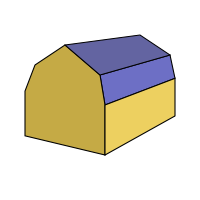Gambrel





Gambrel refers to a symmetrical two-sided roof with two slopes on each side. The lower slope is steeper than the upper one, which is almost flat in comparison. This design allows for more living or storage space in the attic or the upper floor of a building. The gambrel roof is often associated with barns in North America, particularly those built in the Dutch colonial style, but it can also be found in residential architecture.
History[edit]
The gambrel roof has its origins in Europe, but it became especially popular in North America during the 18th century. The design was initially brought over by Dutch settlers, which is why it is often associated with Dutch colonial architecture. The name "gambrel" itself is derived from the Medieval Latin word gamba, meaning horse's hock or leg, which the shape of the roof resembles.
Design and Features[edit]
A key feature of the gambrel roof is its ability to provide more space under the roof without the need for a taller building. This design was particularly useful for agricultural buildings, such as barns, where it was necessary to maximize storage space without increasing the footprint of the building. In residential buildings, the gambrel roof allows for spacious attics or top-floor apartments.
The gambrel roof is characterized by two distinct slopes on each side: the upper slope is at a shallow angle, while the lower slope is much steeper. This configuration not only increases the interior space but also helps in shedding snow and rain more efficiently than a traditional gable roof.
Advantages and Disadvantages[edit]
Advantages[edit]
- Increased space: The gambrel roof provides additional living or storage space in the attic or upper floors.
- Aesthetic appeal: Its unique shape can add character and aesthetic appeal to buildings.
- Efficient water and snow shedding: The steep lower slope allows for better water and snow runoff, reducing the risk of water damage.
Disadvantages[edit]
- Structural complexity: The design and construction of a gambrel roof can be more complex than that of a simple gable roof.
- Maintenance: The additional seams and angles can make maintenance and repair more challenging.
- Wind vulnerability: The larger surface area of the gambrel roof can make it more susceptible to damage from high winds.
Applications[edit]
While traditionally associated with barns and agricultural buildings, the gambrel roof has also been used in residential architecture. It is particularly common in homes designed in the Dutch colonial revival style, as well as in some Cape Cod and colonial revival houses. The gambrel roof's ability to provide additional space makes it a popular choice for attic conversions and extensions.
See Also[edit]

This article is a architecture-related stub. You can help WikiMD by expanding it!
Ad. Transform your life with W8MD's Budget GLP-1 injections from $75


W8MD offers a medical weight loss program to lose weight in Philadelphia. Our physician-supervised medical weight loss provides:
- Weight loss injections in NYC (generic and brand names):
- Zepbound / Mounjaro, Wegovy / Ozempic, Saxenda
- Most insurances accepted or discounted self-pay rates. We will obtain insurance prior authorizations if needed.
- Generic GLP1 weight loss injections from $75 for the starting dose.
- Also offer prescription weight loss medications including Phentermine, Qsymia, Diethylpropion, Contrave etc.
NYC weight loss doctor appointmentsNYC weight loss doctor appointments
Start your NYC weight loss journey today at our NYC medical weight loss and Philadelphia medical weight loss clinics.
- Call 718-946-5500 to lose weight in NYC or for medical weight loss in Philadelphia 215-676-2334.
- Tags:NYC medical weight loss, Philadelphia lose weight Zepbound NYC, Budget GLP1 weight loss injections, Wegovy Philadelphia, Wegovy NYC, Philadelphia medical weight loss, Brookly weight loss and Wegovy NYC
|
WikiMD's Wellness Encyclopedia |
| Let Food Be Thy Medicine Medicine Thy Food - Hippocrates |
Medical Disclaimer: WikiMD is not a substitute for professional medical advice. The information on WikiMD is provided as an information resource only, may be incorrect, outdated or misleading, and is not to be used or relied on for any diagnostic or treatment purposes. Please consult your health care provider before making any healthcare decisions or for guidance about a specific medical condition. WikiMD expressly disclaims responsibility, and shall have no liability, for any damages, loss, injury, or liability whatsoever suffered as a result of your reliance on the information contained in this site. By visiting this site you agree to the foregoing terms and conditions, which may from time to time be changed or supplemented by WikiMD. If you do not agree to the foregoing terms and conditions, you should not enter or use this site. See full disclaimer.
Credits:Most images are courtesy of Wikimedia commons, and templates, categories Wikipedia, licensed under CC BY SA or similar.
Translate this page: - East Asian
中文,
日本,
한국어,
South Asian
हिन्दी,
தமிழ்,
తెలుగు,
Urdu,
ಕನ್ನಡ,
Southeast Asian
Indonesian,
Vietnamese,
Thai,
မြန်မာဘာသာ,
বাংলা
European
español,
Deutsch,
français,
Greek,
português do Brasil,
polski,
română,
русский,
Nederlands,
norsk,
svenska,
suomi,
Italian
Middle Eastern & African
عربى,
Turkish,
Persian,
Hebrew,
Afrikaans,
isiZulu,
Kiswahili,
Other
Bulgarian,
Hungarian,
Czech,
Swedish,
മലയാളം,
मराठी,
ਪੰਜਾਬੀ,
ગુજરાતી,
Portuguese,
Ukrainian